Management Report: Strategic Analysis of Johnson & Johnson
VerifiedAdded on 2023/04/22
|11
|3090
|194
Report
AI Summary
This report provides a comprehensive management analysis of Johnson & Johnson, examining its business activities and strategic environment. The report begins with an overview of the company, followed by an analysis of its external environment using PESTLE and Porter's Five Forces models. The PESTLE analysis assesses political, economic, social, technological, legal, and environmental factors influencing J&J's performance. The Porter's Five Forces analysis evaluates the competitive forces within the healthcare industry, including the threat of new entrants, the bargaining power of buyers and suppliers, the rivalry among existing firms, and the threat of substitute products. The report also offers recommendations for strategic growth and development, focusing on continuous innovation, product diversification, effective supply chain management, and investments in public health. The analysis highlights J&J's competitive advantages and provides insights into its future prospects.
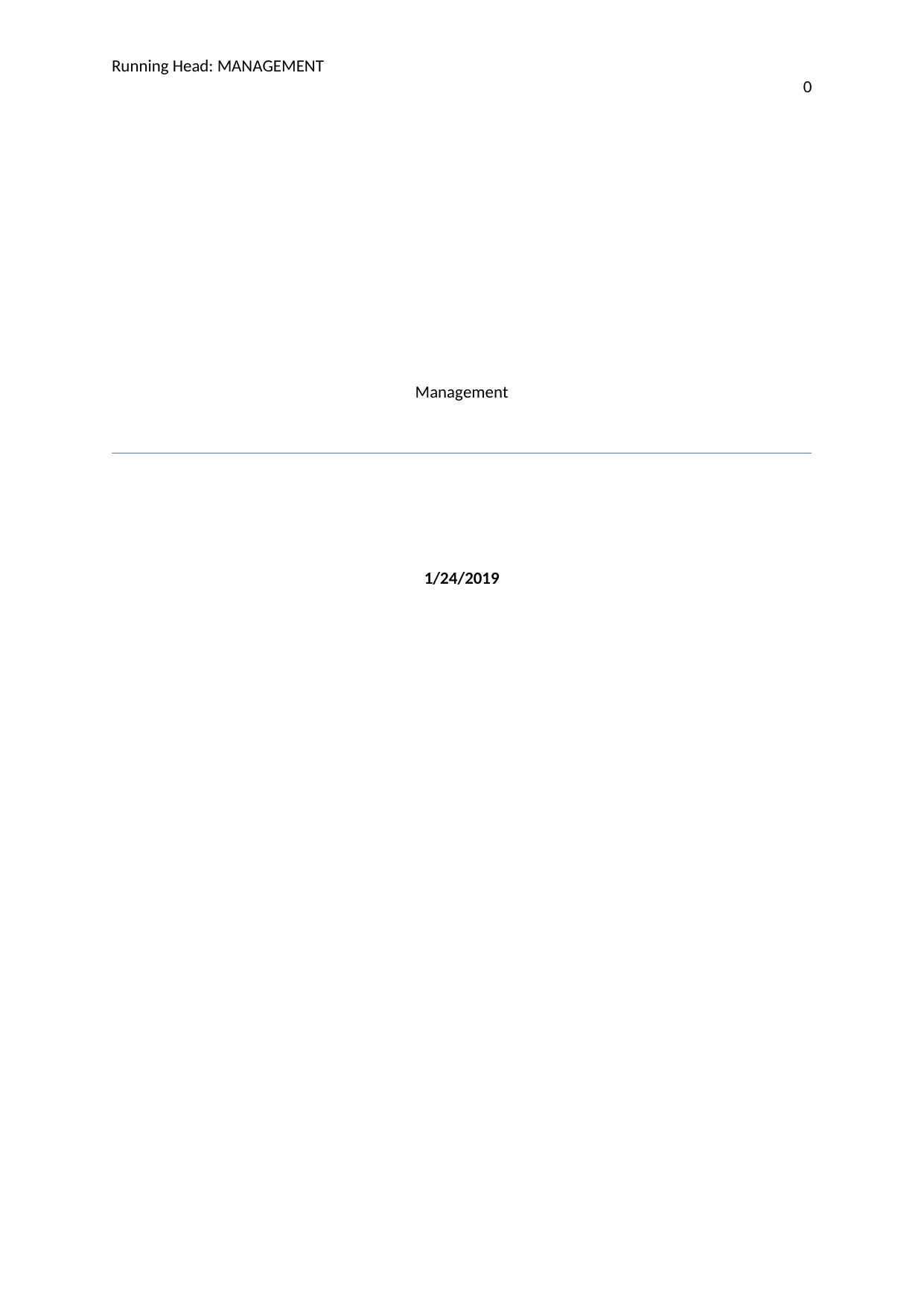
Running Head: MANAGEMENT
0
Management
1/24/2019
0
Management
1/24/2019
Paraphrase This Document
Need a fresh take? Get an instant paraphrase of this document with our AI Paraphraser
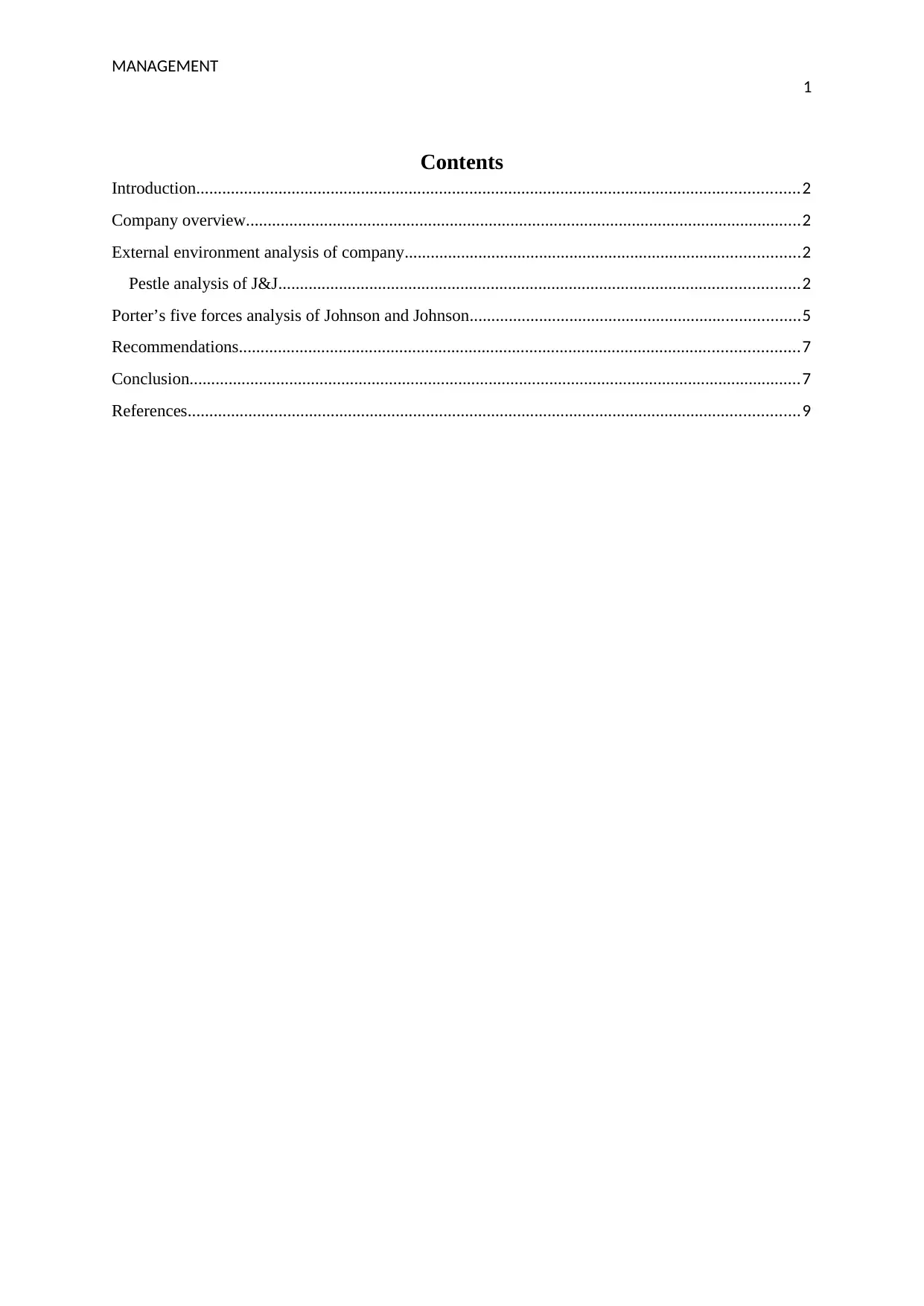
MANAGEMENT
1
Contents
Introduction...........................................................................................................................................2
Company overview................................................................................................................................2
External environment analysis of company...........................................................................................2
Pestle analysis of J&J........................................................................................................................2
Porter’s five forces analysis of Johnson and Johnson............................................................................5
Recommendations.................................................................................................................................7
Conclusion.............................................................................................................................................7
References.............................................................................................................................................9
1
Contents
Introduction...........................................................................................................................................2
Company overview................................................................................................................................2
External environment analysis of company...........................................................................................2
Pestle analysis of J&J........................................................................................................................2
Porter’s five forces analysis of Johnson and Johnson............................................................................5
Recommendations.................................................................................................................................7
Conclusion.............................................................................................................................................7
References.............................................................................................................................................9
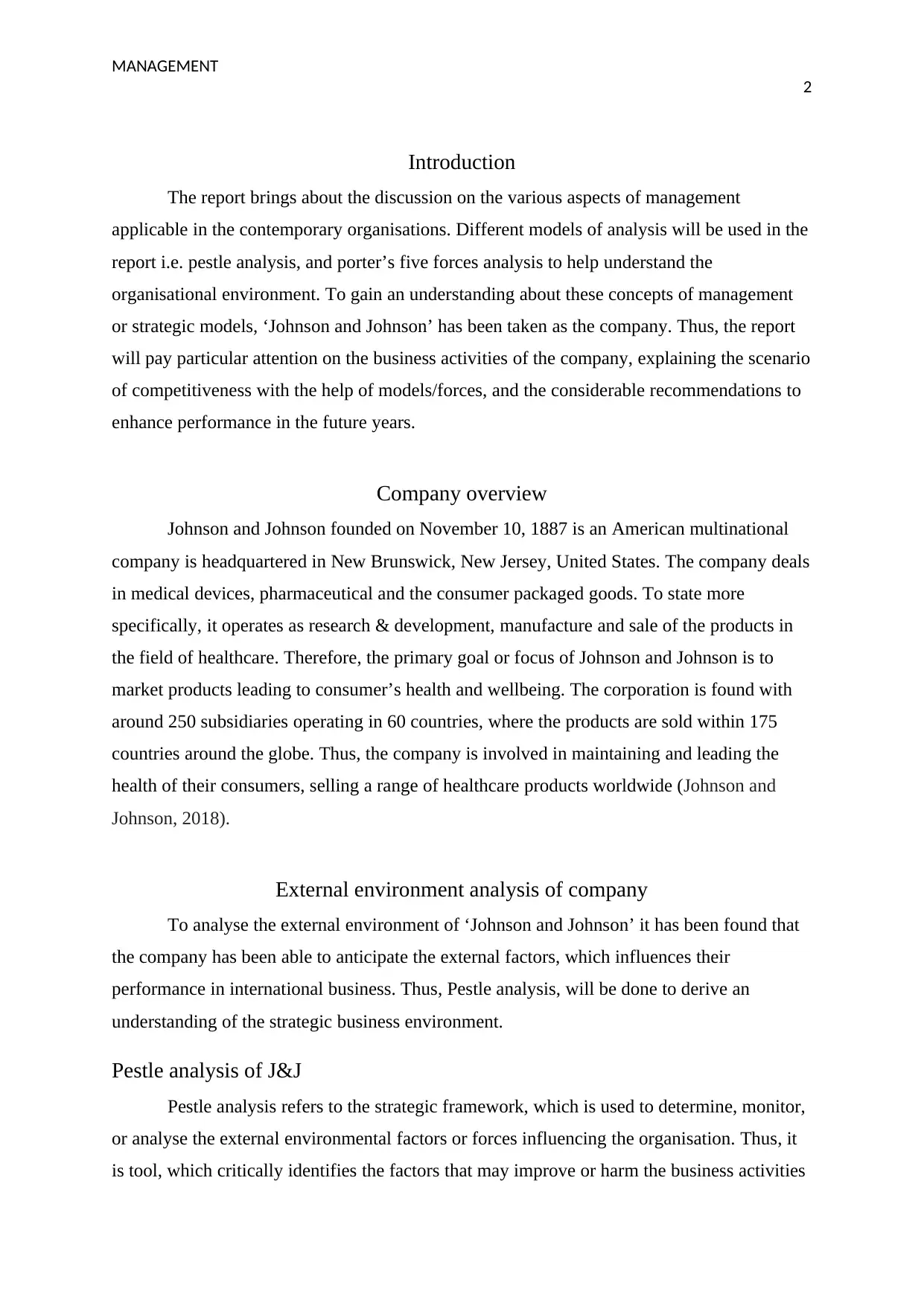
MANAGEMENT
2
Introduction
The report brings about the discussion on the various aspects of management
applicable in the contemporary organisations. Different models of analysis will be used in the
report i.e. pestle analysis, and porter’s five forces analysis to help understand the
organisational environment. To gain an understanding about these concepts of management
or strategic models, ‘Johnson and Johnson’ has been taken as the company. Thus, the report
will pay particular attention on the business activities of the company, explaining the scenario
of competitiveness with the help of models/forces, and the considerable recommendations to
enhance performance in the future years.
Company overview
Johnson and Johnson founded on November 10, 1887 is an American multinational
company is headquartered in New Brunswick, New Jersey, United States. The company deals
in medical devices, pharmaceutical and the consumer packaged goods. To state more
specifically, it operates as research & development, manufacture and sale of the products in
the field of healthcare. Therefore, the primary goal or focus of Johnson and Johnson is to
market products leading to consumer’s health and wellbeing. The corporation is found with
around 250 subsidiaries operating in 60 countries, where the products are sold within 175
countries around the globe. Thus, the company is involved in maintaining and leading the
health of their consumers, selling a range of healthcare products worldwide (Johnson and
Johnson, 2018).
External environment analysis of company
To analyse the external environment of ‘Johnson and Johnson’ it has been found that
the company has been able to anticipate the external factors, which influences their
performance in international business. Thus, Pestle analysis, will be done to derive an
understanding of the strategic business environment.
Pestle analysis of J&J
Pestle analysis refers to the strategic framework, which is used to determine, monitor,
or analyse the external environmental factors or forces influencing the organisation. Thus, it
is tool, which critically identifies the factors that may improve or harm the business activities
2
Introduction
The report brings about the discussion on the various aspects of management
applicable in the contemporary organisations. Different models of analysis will be used in the
report i.e. pestle analysis, and porter’s five forces analysis to help understand the
organisational environment. To gain an understanding about these concepts of management
or strategic models, ‘Johnson and Johnson’ has been taken as the company. Thus, the report
will pay particular attention on the business activities of the company, explaining the scenario
of competitiveness with the help of models/forces, and the considerable recommendations to
enhance performance in the future years.
Company overview
Johnson and Johnson founded on November 10, 1887 is an American multinational
company is headquartered in New Brunswick, New Jersey, United States. The company deals
in medical devices, pharmaceutical and the consumer packaged goods. To state more
specifically, it operates as research & development, manufacture and sale of the products in
the field of healthcare. Therefore, the primary goal or focus of Johnson and Johnson is to
market products leading to consumer’s health and wellbeing. The corporation is found with
around 250 subsidiaries operating in 60 countries, where the products are sold within 175
countries around the globe. Thus, the company is involved in maintaining and leading the
health of their consumers, selling a range of healthcare products worldwide (Johnson and
Johnson, 2018).
External environment analysis of company
To analyse the external environment of ‘Johnson and Johnson’ it has been found that
the company has been able to anticipate the external factors, which influences their
performance in international business. Thus, Pestle analysis, will be done to derive an
understanding of the strategic business environment.
Pestle analysis of J&J
Pestle analysis refers to the strategic framework, which is used to determine, monitor,
or analyse the external environmental factors or forces influencing the organisation. Thus, it
is tool, which critically identifies the factors that may improve or harm the business activities
⊘ This is a preview!⊘
Do you want full access?
Subscribe today to unlock all pages.

Trusted by 1+ million students worldwide
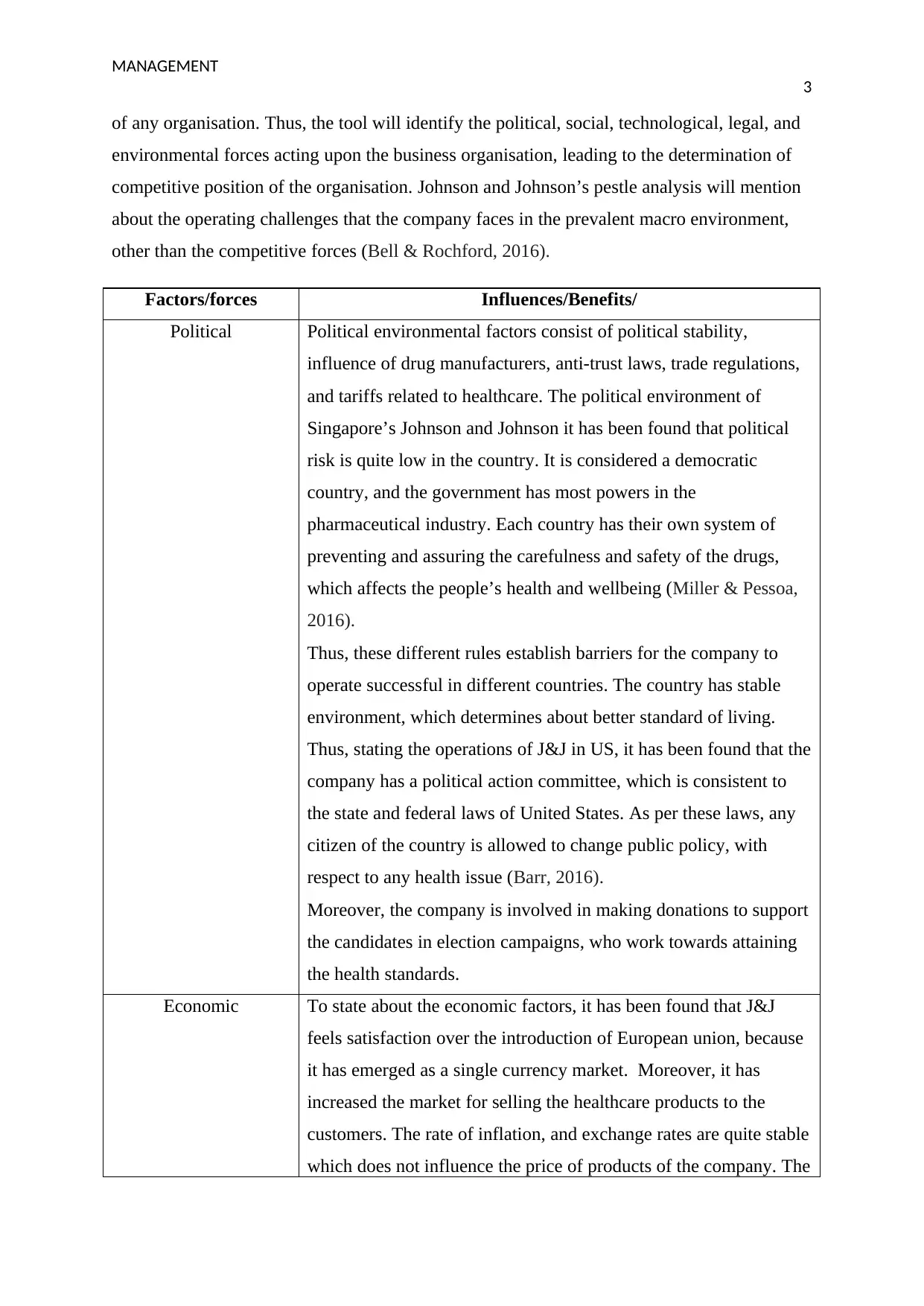
MANAGEMENT
3
of any organisation. Thus, the tool will identify the political, social, technological, legal, and
environmental forces acting upon the business organisation, leading to the determination of
competitive position of the organisation. Johnson and Johnson’s pestle analysis will mention
about the operating challenges that the company faces in the prevalent macro environment,
other than the competitive forces (Bell & Rochford, 2016).
Factors/forces Influences/Benefits/
Political Political environmental factors consist of political stability,
influence of drug manufacturers, anti-trust laws, trade regulations,
and tariffs related to healthcare. The political environment of
Singapore’s Johnson and Johnson it has been found that political
risk is quite low in the country. It is considered a democratic
country, and the government has most powers in the
pharmaceutical industry. Each country has their own system of
preventing and assuring the carefulness and safety of the drugs,
which affects the people’s health and wellbeing (Miller & Pessoa,
2016).
Thus, these different rules establish barriers for the company to
operate successful in different countries. The country has stable
environment, which determines about better standard of living.
Thus, stating the operations of J&J in US, it has been found that the
company has a political action committee, which is consistent to
the state and federal laws of United States. As per these laws, any
citizen of the country is allowed to change public policy, with
respect to any health issue (Barr, 2016).
Moreover, the company is involved in making donations to support
the candidates in election campaigns, who work towards attaining
the health standards.
Economic To state about the economic factors, it has been found that J&J
feels satisfaction over the introduction of European union, because
it has emerged as a single currency market. Moreover, it has
increased the market for selling the healthcare products to the
customers. The rate of inflation, and exchange rates are quite stable
which does not influence the price of products of the company. The
3
of any organisation. Thus, the tool will identify the political, social, technological, legal, and
environmental forces acting upon the business organisation, leading to the determination of
competitive position of the organisation. Johnson and Johnson’s pestle analysis will mention
about the operating challenges that the company faces in the prevalent macro environment,
other than the competitive forces (Bell & Rochford, 2016).
Factors/forces Influences/Benefits/
Political Political environmental factors consist of political stability,
influence of drug manufacturers, anti-trust laws, trade regulations,
and tariffs related to healthcare. The political environment of
Singapore’s Johnson and Johnson it has been found that political
risk is quite low in the country. It is considered a democratic
country, and the government has most powers in the
pharmaceutical industry. Each country has their own system of
preventing and assuring the carefulness and safety of the drugs,
which affects the people’s health and wellbeing (Miller & Pessoa,
2016).
Thus, these different rules establish barriers for the company to
operate successful in different countries. The country has stable
environment, which determines about better standard of living.
Thus, stating the operations of J&J in US, it has been found that the
company has a political action committee, which is consistent to
the state and federal laws of United States. As per these laws, any
citizen of the country is allowed to change public policy, with
respect to any health issue (Barr, 2016).
Moreover, the company is involved in making donations to support
the candidates in election campaigns, who work towards attaining
the health standards.
Economic To state about the economic factors, it has been found that J&J
feels satisfaction over the introduction of European union, because
it has emerged as a single currency market. Moreover, it has
increased the market for selling the healthcare products to the
customers. The rate of inflation, and exchange rates are quite stable
which does not influence the price of products of the company. The
Paraphrase This Document
Need a fresh take? Get an instant paraphrase of this document with our AI Paraphraser
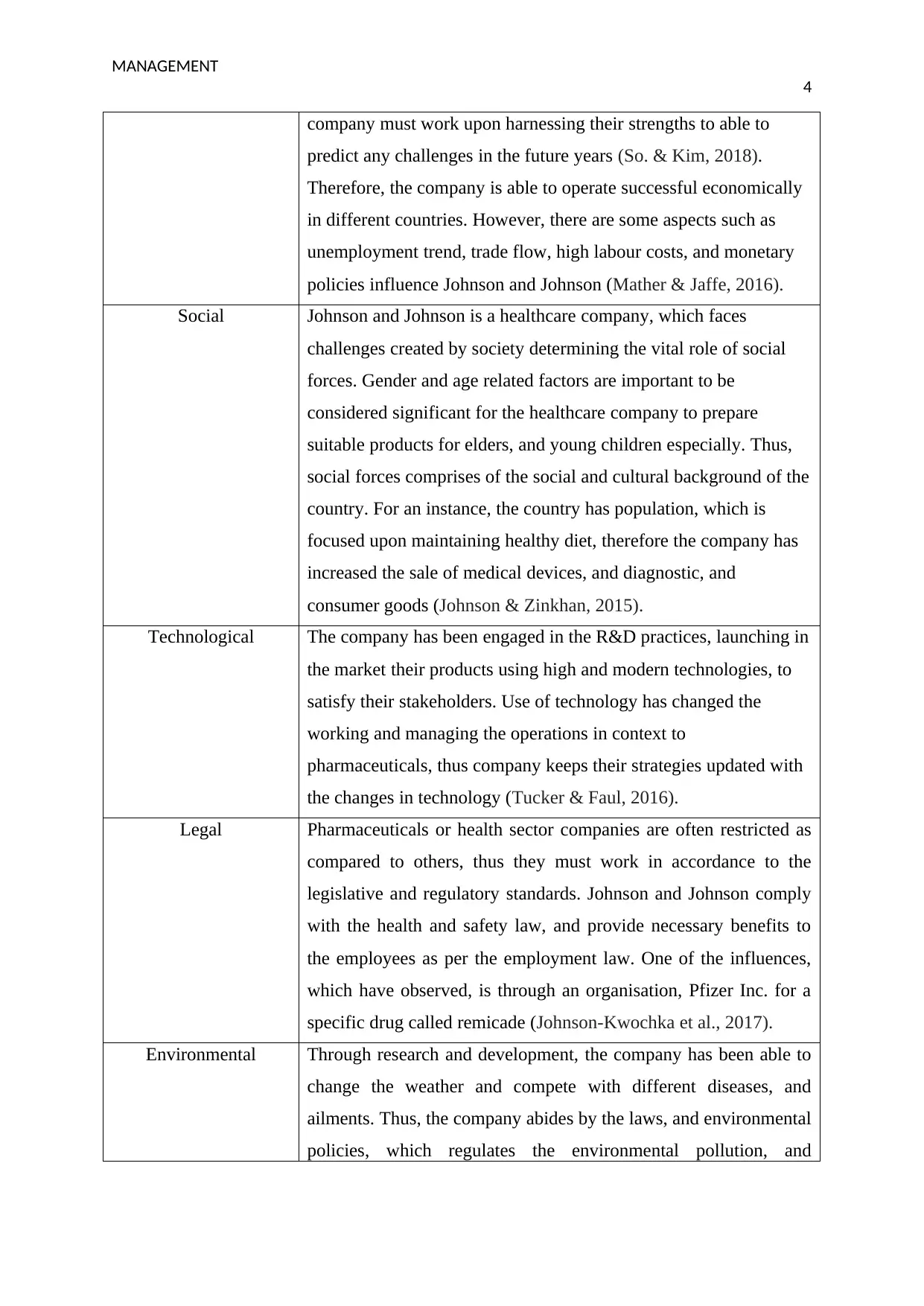
MANAGEMENT
4
company must work upon harnessing their strengths to able to
predict any challenges in the future years (So. & Kim, 2018).
Therefore, the company is able to operate successful economically
in different countries. However, there are some aspects such as
unemployment trend, trade flow, high labour costs, and monetary
policies influence Johnson and Johnson (Mather & Jaffe, 2016).
Social Johnson and Johnson is a healthcare company, which faces
challenges created by society determining the vital role of social
forces. Gender and age related factors are important to be
considered significant for the healthcare company to prepare
suitable products for elders, and young children especially. Thus,
social forces comprises of the social and cultural background of the
country. For an instance, the country has population, which is
focused upon maintaining healthy diet, therefore the company has
increased the sale of medical devices, and diagnostic, and
consumer goods (Johnson & Zinkhan, 2015).
Technological The company has been engaged in the R&D practices, launching in
the market their products using high and modern technologies, to
satisfy their stakeholders. Use of technology has changed the
working and managing the operations in context to
pharmaceuticals, thus company keeps their strategies updated with
the changes in technology (Tucker & Faul, 2016).
Legal Pharmaceuticals or health sector companies are often restricted as
compared to others, thus they must work in accordance to the
legislative and regulatory standards. Johnson and Johnson comply
with the health and safety law, and provide necessary benefits to
the employees as per the employment law. One of the influences,
which have observed, is through an organisation, Pfizer Inc. for a
specific drug called remicade (Johnson-Kwochka et al., 2017).
Environmental Through research and development, the company has been able to
change the weather and compete with different diseases, and
ailments. Thus, the company abides by the laws, and environmental
policies, which regulates the environmental pollution, and
4
company must work upon harnessing their strengths to able to
predict any challenges in the future years (So. & Kim, 2018).
Therefore, the company is able to operate successful economically
in different countries. However, there are some aspects such as
unemployment trend, trade flow, high labour costs, and monetary
policies influence Johnson and Johnson (Mather & Jaffe, 2016).
Social Johnson and Johnson is a healthcare company, which faces
challenges created by society determining the vital role of social
forces. Gender and age related factors are important to be
considered significant for the healthcare company to prepare
suitable products for elders, and young children especially. Thus,
social forces comprises of the social and cultural background of the
country. For an instance, the country has population, which is
focused upon maintaining healthy diet, therefore the company has
increased the sale of medical devices, and diagnostic, and
consumer goods (Johnson & Zinkhan, 2015).
Technological The company has been engaged in the R&D practices, launching in
the market their products using high and modern technologies, to
satisfy their stakeholders. Use of technology has changed the
working and managing the operations in context to
pharmaceuticals, thus company keeps their strategies updated with
the changes in technology (Tucker & Faul, 2016).
Legal Pharmaceuticals or health sector companies are often restricted as
compared to others, thus they must work in accordance to the
legislative and regulatory standards. Johnson and Johnson comply
with the health and safety law, and provide necessary benefits to
the employees as per the employment law. One of the influences,
which have observed, is through an organisation, Pfizer Inc. for a
specific drug called remicade (Johnson-Kwochka et al., 2017).
Environmental Through research and development, the company has been able to
change the weather and compete with different diseases, and
ailments. Thus, the company abides by the laws, and environmental
policies, which regulates the environmental pollution, and
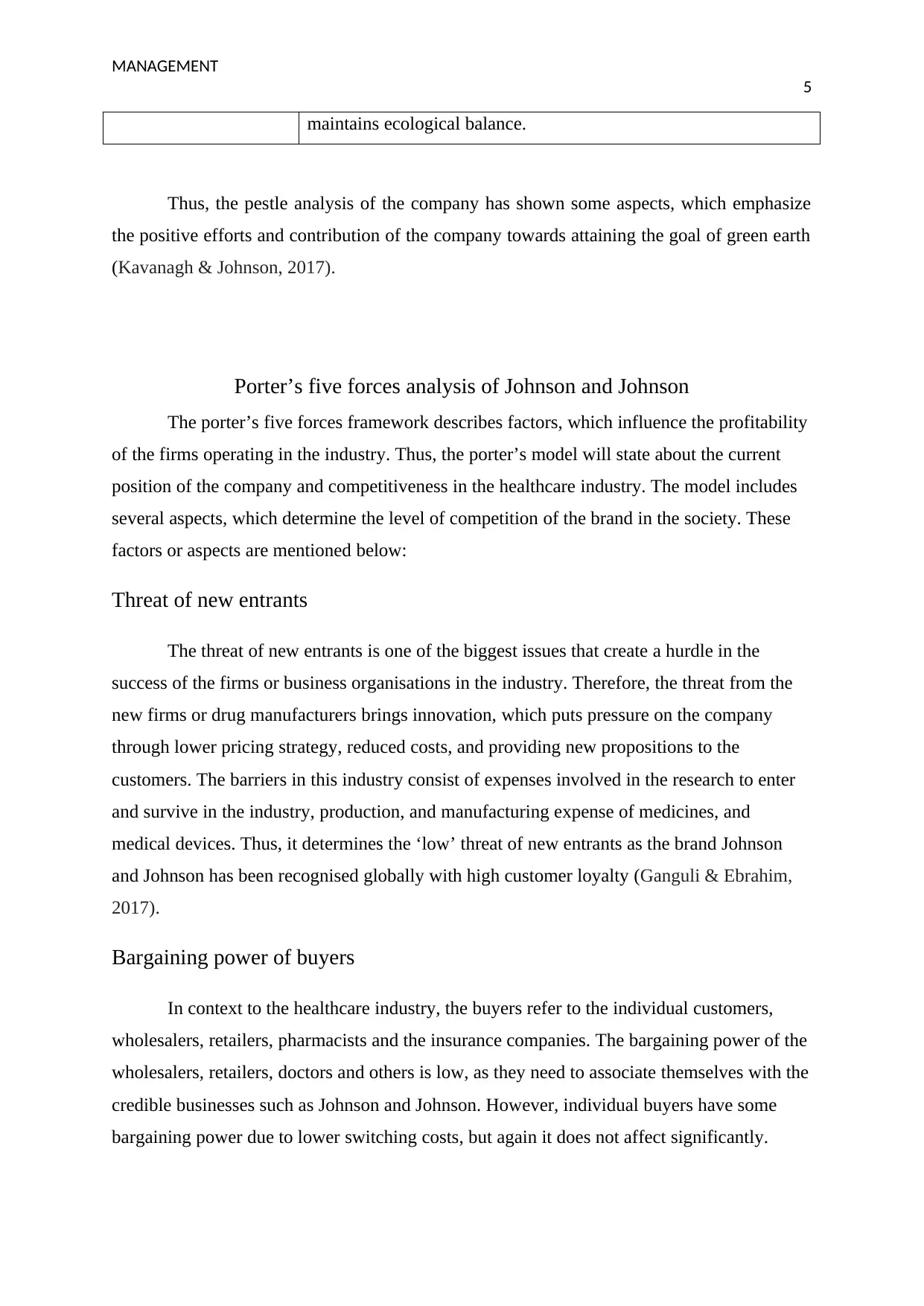
MANAGEMENT
5
maintains ecological balance.
Thus, the pestle analysis of the company has shown some aspects, which emphasize
the positive efforts and contribution of the company towards attaining the goal of green earth
(Kavanagh & Johnson, 2017).
Porter’s five forces analysis of Johnson and Johnson
The porter’s five forces framework describes factors, which influence the profitability
of the firms operating in the industry. Thus, the porter’s model will state about the current
position of the company and competitiveness in the healthcare industry. The model includes
several aspects, which determine the level of competition of the brand in the society. These
factors or aspects are mentioned below:
Threat of new entrants
The threat of new entrants is one of the biggest issues that create a hurdle in the
success of the firms or business organisations in the industry. Therefore, the threat from the
new firms or drug manufacturers brings innovation, which puts pressure on the company
through lower pricing strategy, reduced costs, and providing new propositions to the
customers. The barriers in this industry consist of expenses involved in the research to enter
and survive in the industry, production, and manufacturing expense of medicines, and
medical devices. Thus, it determines the ‘low’ threat of new entrants as the brand Johnson
and Johnson has been recognised globally with high customer loyalty (Ganguli & Ebrahim,
2017).
Bargaining power of buyers
In context to the healthcare industry, the buyers refer to the individual customers,
wholesalers, retailers, pharmacists and the insurance companies. The bargaining power of the
wholesalers, retailers, doctors and others is low, as they need to associate themselves with the
credible businesses such as Johnson and Johnson. However, individual buyers have some
bargaining power due to lower switching costs, but again it does not affect significantly.
5
maintains ecological balance.
Thus, the pestle analysis of the company has shown some aspects, which emphasize
the positive efforts and contribution of the company towards attaining the goal of green earth
(Kavanagh & Johnson, 2017).
Porter’s five forces analysis of Johnson and Johnson
The porter’s five forces framework describes factors, which influence the profitability
of the firms operating in the industry. Thus, the porter’s model will state about the current
position of the company and competitiveness in the healthcare industry. The model includes
several aspects, which determine the level of competition of the brand in the society. These
factors or aspects are mentioned below:
Threat of new entrants
The threat of new entrants is one of the biggest issues that create a hurdle in the
success of the firms or business organisations in the industry. Therefore, the threat from the
new firms or drug manufacturers brings innovation, which puts pressure on the company
through lower pricing strategy, reduced costs, and providing new propositions to the
customers. The barriers in this industry consist of expenses involved in the research to enter
and survive in the industry, production, and manufacturing expense of medicines, and
medical devices. Thus, it determines the ‘low’ threat of new entrants as the brand Johnson
and Johnson has been recognised globally with high customer loyalty (Ganguli & Ebrahim,
2017).
Bargaining power of buyers
In context to the healthcare industry, the buyers refer to the individual customers,
wholesalers, retailers, pharmacists and the insurance companies. The bargaining power of the
wholesalers, retailers, doctors and others is low, as they need to associate themselves with the
credible businesses such as Johnson and Johnson. However, individual buyers have some
bargaining power due to lower switching costs, but again it does not affect significantly.
⊘ This is a preview!⊘
Do you want full access?
Subscribe today to unlock all pages.

Trusted by 1+ million students worldwide
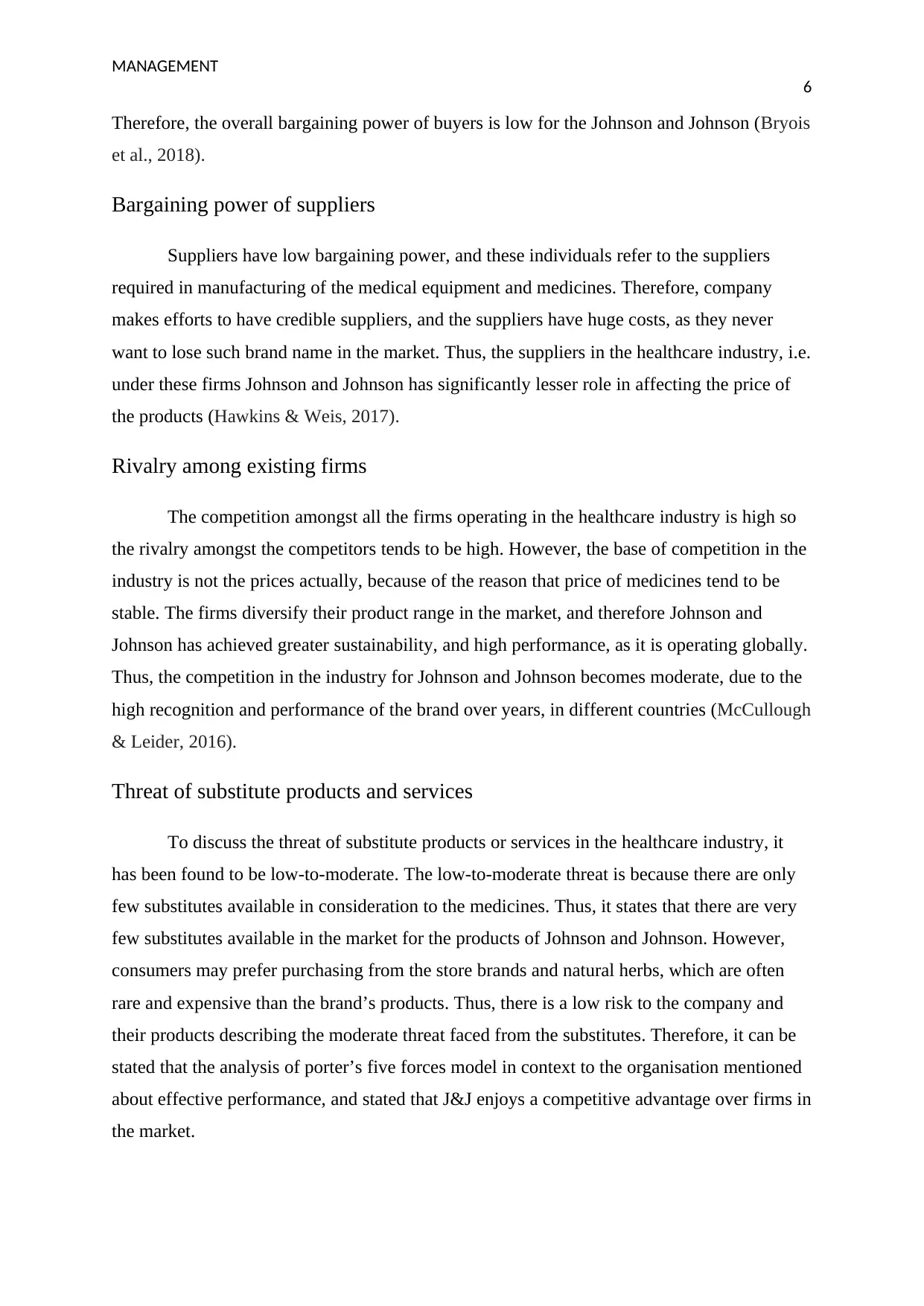
MANAGEMENT
6
Therefore, the overall bargaining power of buyers is low for the Johnson and Johnson (Bryois
et al., 2018).
Bargaining power of suppliers
Suppliers have low bargaining power, and these individuals refer to the suppliers
required in manufacturing of the medical equipment and medicines. Therefore, company
makes efforts to have credible suppliers, and the suppliers have huge costs, as they never
want to lose such brand name in the market. Thus, the suppliers in the healthcare industry, i.e.
under these firms Johnson and Johnson has significantly lesser role in affecting the price of
the products (Hawkins & Weis, 2017).
Rivalry among existing firms
The competition amongst all the firms operating in the healthcare industry is high so
the rivalry amongst the competitors tends to be high. However, the base of competition in the
industry is not the prices actually, because of the reason that price of medicines tend to be
stable. The firms diversify their product range in the market, and therefore Johnson and
Johnson has achieved greater sustainability, and high performance, as it is operating globally.
Thus, the competition in the industry for Johnson and Johnson becomes moderate, due to the
high recognition and performance of the brand over years, in different countries (McCullough
& Leider, 2016).
Threat of substitute products and services
To discuss the threat of substitute products or services in the healthcare industry, it
has been found to be low-to-moderate. The low-to-moderate threat is because there are only
few substitutes available in consideration to the medicines. Thus, it states that there are very
few substitutes available in the market for the products of Johnson and Johnson. However,
consumers may prefer purchasing from the store brands and natural herbs, which are often
rare and expensive than the brand’s products. Thus, there is a low risk to the company and
their products describing the moderate threat faced from the substitutes. Therefore, it can be
stated that the analysis of porter’s five forces model in context to the organisation mentioned
about effective performance, and stated that J&J enjoys a competitive advantage over firms in
the market.
6
Therefore, the overall bargaining power of buyers is low for the Johnson and Johnson (Bryois
et al., 2018).
Bargaining power of suppliers
Suppliers have low bargaining power, and these individuals refer to the suppliers
required in manufacturing of the medical equipment and medicines. Therefore, company
makes efforts to have credible suppliers, and the suppliers have huge costs, as they never
want to lose such brand name in the market. Thus, the suppliers in the healthcare industry, i.e.
under these firms Johnson and Johnson has significantly lesser role in affecting the price of
the products (Hawkins & Weis, 2017).
Rivalry among existing firms
The competition amongst all the firms operating in the healthcare industry is high so
the rivalry amongst the competitors tends to be high. However, the base of competition in the
industry is not the prices actually, because of the reason that price of medicines tend to be
stable. The firms diversify their product range in the market, and therefore Johnson and
Johnson has achieved greater sustainability, and high performance, as it is operating globally.
Thus, the competition in the industry for Johnson and Johnson becomes moderate, due to the
high recognition and performance of the brand over years, in different countries (McCullough
& Leider, 2016).
Threat of substitute products and services
To discuss the threat of substitute products or services in the healthcare industry, it
has been found to be low-to-moderate. The low-to-moderate threat is because there are only
few substitutes available in consideration to the medicines. Thus, it states that there are very
few substitutes available in the market for the products of Johnson and Johnson. However,
consumers may prefer purchasing from the store brands and natural herbs, which are often
rare and expensive than the brand’s products. Thus, there is a low risk to the company and
their products describing the moderate threat faced from the substitutes. Therefore, it can be
stated that the analysis of porter’s five forces model in context to the organisation mentioned
about effective performance, and stated that J&J enjoys a competitive advantage over firms in
the market.
Paraphrase This Document
Need a fresh take? Get an instant paraphrase of this document with our AI Paraphraser
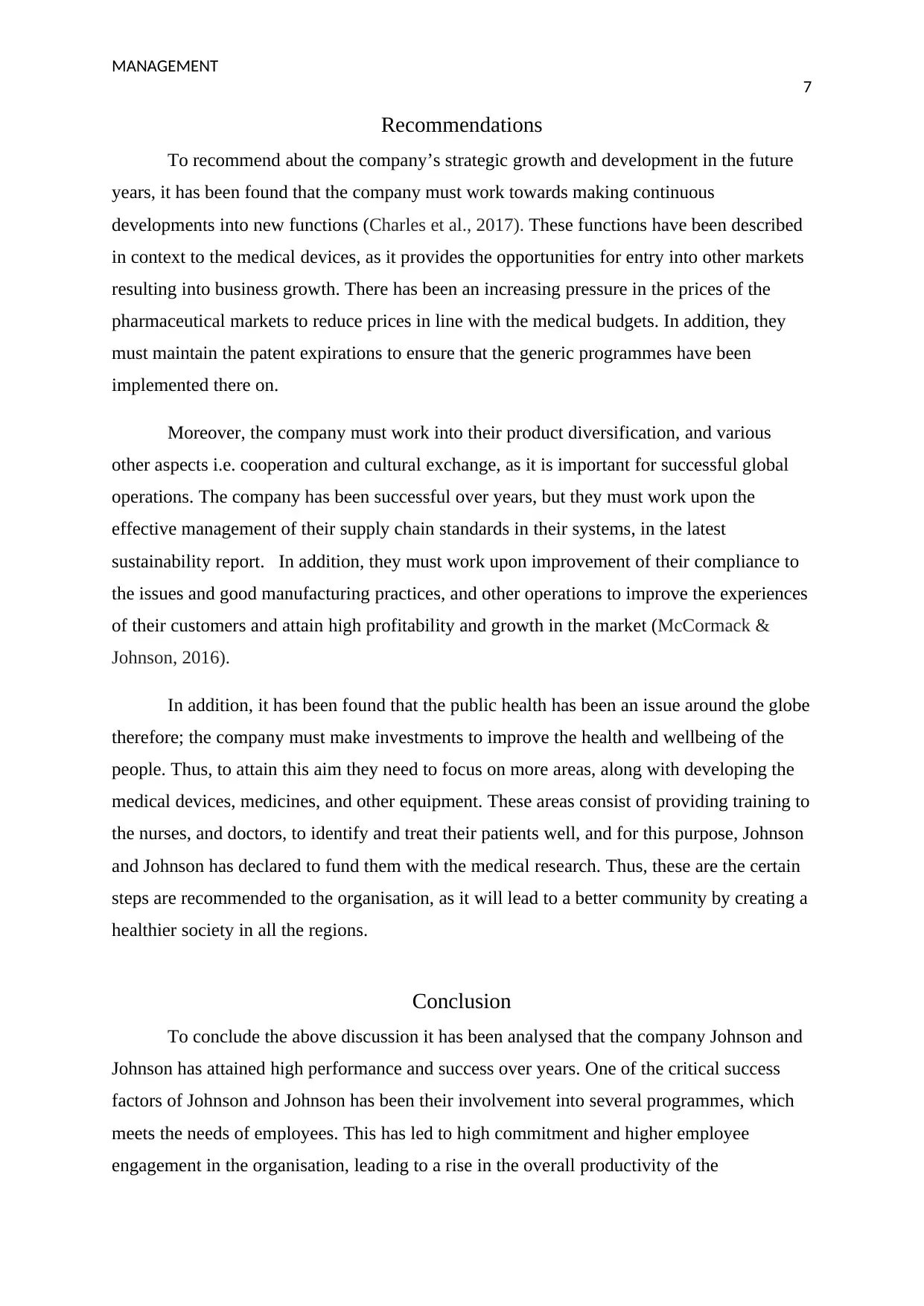
MANAGEMENT
7
Recommendations
To recommend about the company’s strategic growth and development in the future
years, it has been found that the company must work towards making continuous
developments into new functions (Charles et al., 2017). These functions have been described
in context to the medical devices, as it provides the opportunities for entry into other markets
resulting into business growth. There has been an increasing pressure in the prices of the
pharmaceutical markets to reduce prices in line with the medical budgets. In addition, they
must maintain the patent expirations to ensure that the generic programmes have been
implemented there on.
Moreover, the company must work into their product diversification, and various
other aspects i.e. cooperation and cultural exchange, as it is important for successful global
operations. The company has been successful over years, but they must work upon the
effective management of their supply chain standards in their systems, in the latest
sustainability report. In addition, they must work upon improvement of their compliance to
the issues and good manufacturing practices, and other operations to improve the experiences
of their customers and attain high profitability and growth in the market (McCormack &
Johnson, 2016).
In addition, it has been found that the public health has been an issue around the globe
therefore; the company must make investments to improve the health and wellbeing of the
people. Thus, to attain this aim they need to focus on more areas, along with developing the
medical devices, medicines, and other equipment. These areas consist of providing training to
the nurses, and doctors, to identify and treat their patients well, and for this purpose, Johnson
and Johnson has declared to fund them with the medical research. Thus, these are the certain
steps are recommended to the organisation, as it will lead to a better community by creating a
healthier society in all the regions.
Conclusion
To conclude the above discussion it has been analysed that the company Johnson and
Johnson has attained high performance and success over years. One of the critical success
factors of Johnson and Johnson has been their involvement into several programmes, which
meets the needs of employees. This has led to high commitment and higher employee
engagement in the organisation, leading to a rise in the overall productivity of the
7
Recommendations
To recommend about the company’s strategic growth and development in the future
years, it has been found that the company must work towards making continuous
developments into new functions (Charles et al., 2017). These functions have been described
in context to the medical devices, as it provides the opportunities for entry into other markets
resulting into business growth. There has been an increasing pressure in the prices of the
pharmaceutical markets to reduce prices in line with the medical budgets. In addition, they
must maintain the patent expirations to ensure that the generic programmes have been
implemented there on.
Moreover, the company must work into their product diversification, and various
other aspects i.e. cooperation and cultural exchange, as it is important for successful global
operations. The company has been successful over years, but they must work upon the
effective management of their supply chain standards in their systems, in the latest
sustainability report. In addition, they must work upon improvement of their compliance to
the issues and good manufacturing practices, and other operations to improve the experiences
of their customers and attain high profitability and growth in the market (McCormack &
Johnson, 2016).
In addition, it has been found that the public health has been an issue around the globe
therefore; the company must make investments to improve the health and wellbeing of the
people. Thus, to attain this aim they need to focus on more areas, along with developing the
medical devices, medicines, and other equipment. These areas consist of providing training to
the nurses, and doctors, to identify and treat their patients well, and for this purpose, Johnson
and Johnson has declared to fund them with the medical research. Thus, these are the certain
steps are recommended to the organisation, as it will lead to a better community by creating a
healthier society in all the regions.
Conclusion
To conclude the above discussion it has been analysed that the company Johnson and
Johnson has attained high performance and success over years. One of the critical success
factors of Johnson and Johnson has been their involvement into several programmes, which
meets the needs of employees. This has led to high commitment and higher employee
engagement in the organisation, leading to a rise in the overall productivity of the
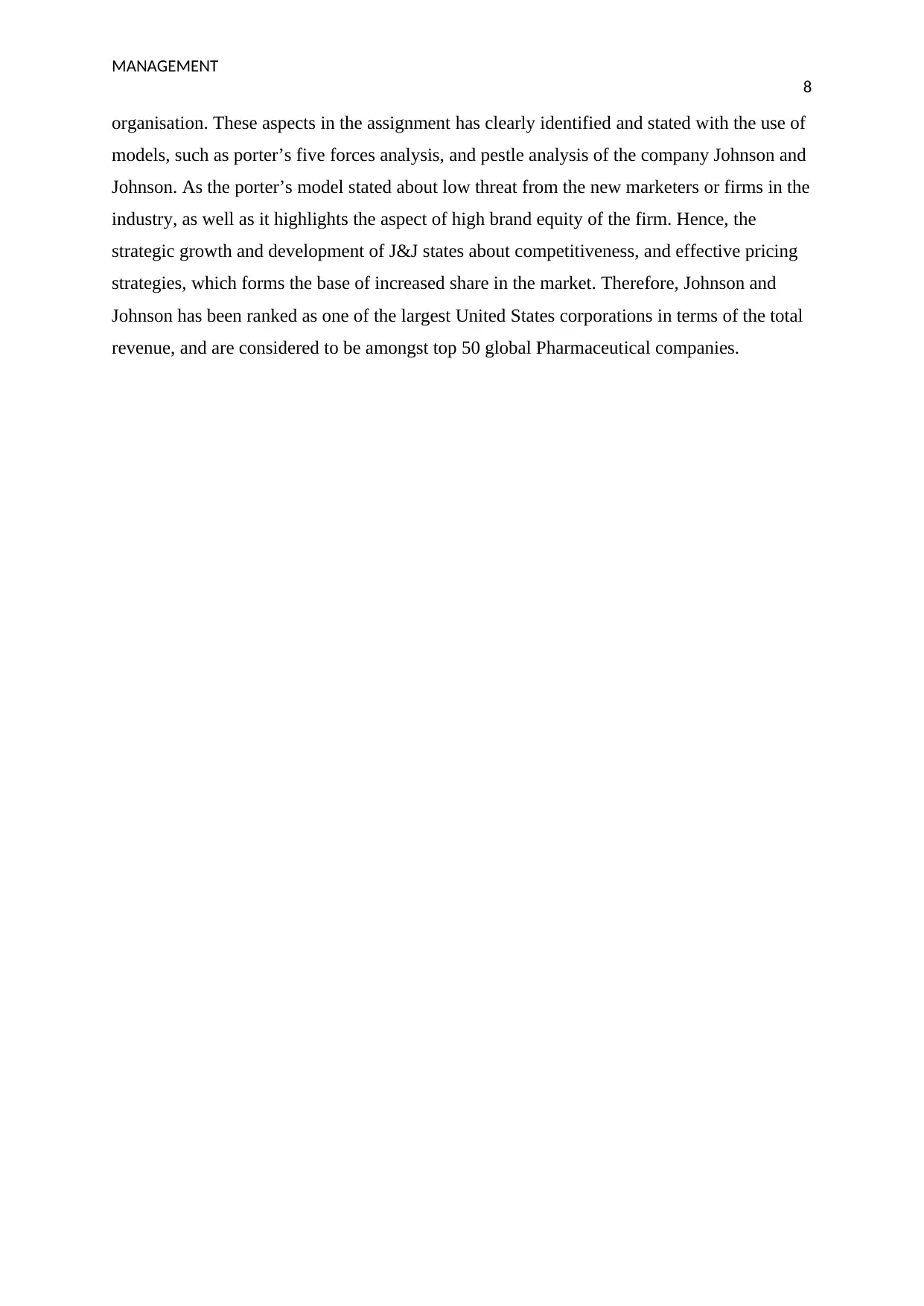
MANAGEMENT
8
organisation. These aspects in the assignment has clearly identified and stated with the use of
models, such as porter’s five forces analysis, and pestle analysis of the company Johnson and
Johnson. As the porter’s model stated about low threat from the new marketers or firms in the
industry, as well as it highlights the aspect of high brand equity of the firm. Hence, the
strategic growth and development of J&J states about competitiveness, and effective pricing
strategies, which forms the base of increased share in the market. Therefore, Johnson and
Johnson has been ranked as one of the largest United States corporations in terms of the total
revenue, and are considered to be amongst top 50 global Pharmaceutical companies.
8
organisation. These aspects in the assignment has clearly identified and stated with the use of
models, such as porter’s five forces analysis, and pestle analysis of the company Johnson and
Johnson. As the porter’s model stated about low threat from the new marketers or firms in the
industry, as well as it highlights the aspect of high brand equity of the firm. Hence, the
strategic growth and development of J&J states about competitiveness, and effective pricing
strategies, which forms the base of increased share in the market. Therefore, Johnson and
Johnson has been ranked as one of the largest United States corporations in terms of the total
revenue, and are considered to be amongst top 50 global Pharmaceutical companies.
⊘ This is a preview!⊘
Do you want full access?
Subscribe today to unlock all pages.

Trusted by 1+ million students worldwide
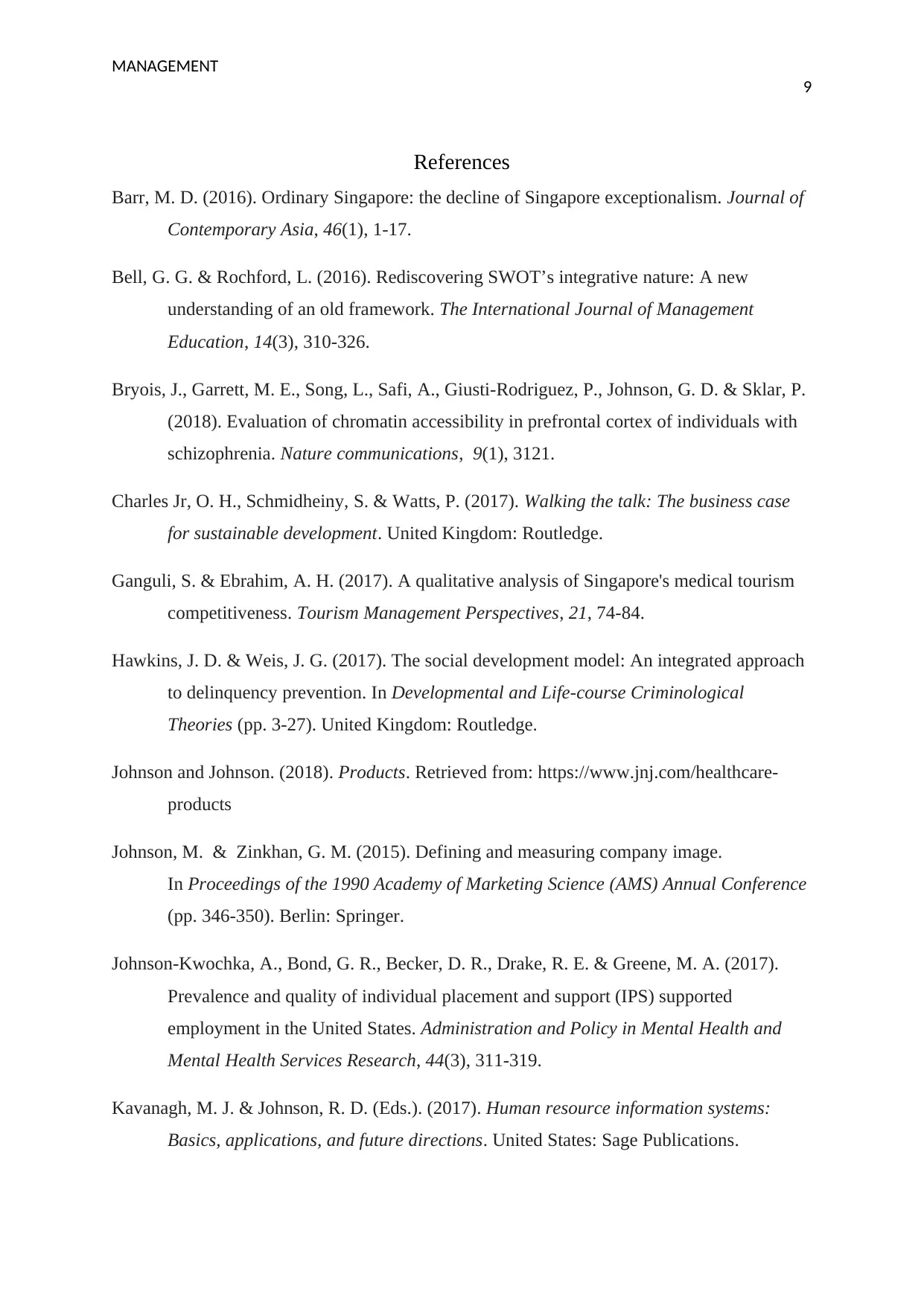
MANAGEMENT
9
References
Barr, M. D. (2016). Ordinary Singapore: the decline of Singapore exceptionalism. Journal of
Contemporary Asia, 46(1), 1-17.
Bell, G. G. & Rochford, L. (2016). Rediscovering SWOT’s integrative nature: A new
understanding of an old framework. The International Journal of Management
Education, 14(3), 310-326.
Bryois, J., Garrett, M. E., Song, L., Safi, A., Giusti-Rodriguez, P., Johnson, G. D. & Sklar, P.
(2018). Evaluation of chromatin accessibility in prefrontal cortex of individuals with
schizophrenia. Nature communications, 9(1), 3121.
Charles Jr, O. H., Schmidheiny, S. & Watts, P. (2017). Walking the talk: The business case
for sustainable development. United Kingdom: Routledge.
Ganguli, S. & Ebrahim, A. H. (2017). A qualitative analysis of Singapore's medical tourism
competitiveness. Tourism Management Perspectives, 21, 74-84.
Hawkins, J. D. & Weis, J. G. (2017). The social development model: An integrated approach
to delinquency prevention. In Developmental and Life-course Criminological
Theories (pp. 3-27). United Kingdom: Routledge.
Johnson and Johnson. (2018). Products. Retrieved from: https://www.jnj.com/healthcare-
products
Johnson, M. & Zinkhan, G. M. (2015). Defining and measuring company image.
In Proceedings of the 1990 Academy of Marketing Science (AMS) Annual Conference
(pp. 346-350). Berlin: Springer.
Johnson-Kwochka, A., Bond, G. R., Becker, D. R., Drake, R. E. & Greene, M. A. (2017).
Prevalence and quality of individual placement and support (IPS) supported
employment in the United States. Administration and Policy in Mental Health and
Mental Health Services Research, 44(3), 311-319.
Kavanagh, M. J. & Johnson, R. D. (Eds.). (2017). Human resource information systems:
Basics, applications, and future directions. United States: Sage Publications.
9
References
Barr, M. D. (2016). Ordinary Singapore: the decline of Singapore exceptionalism. Journal of
Contemporary Asia, 46(1), 1-17.
Bell, G. G. & Rochford, L. (2016). Rediscovering SWOT’s integrative nature: A new
understanding of an old framework. The International Journal of Management
Education, 14(3), 310-326.
Bryois, J., Garrett, M. E., Song, L., Safi, A., Giusti-Rodriguez, P., Johnson, G. D. & Sklar, P.
(2018). Evaluation of chromatin accessibility in prefrontal cortex of individuals with
schizophrenia. Nature communications, 9(1), 3121.
Charles Jr, O. H., Schmidheiny, S. & Watts, P. (2017). Walking the talk: The business case
for sustainable development. United Kingdom: Routledge.
Ganguli, S. & Ebrahim, A. H. (2017). A qualitative analysis of Singapore's medical tourism
competitiveness. Tourism Management Perspectives, 21, 74-84.
Hawkins, J. D. & Weis, J. G. (2017). The social development model: An integrated approach
to delinquency prevention. In Developmental and Life-course Criminological
Theories (pp. 3-27). United Kingdom: Routledge.
Johnson and Johnson. (2018). Products. Retrieved from: https://www.jnj.com/healthcare-
products
Johnson, M. & Zinkhan, G. M. (2015). Defining and measuring company image.
In Proceedings of the 1990 Academy of Marketing Science (AMS) Annual Conference
(pp. 346-350). Berlin: Springer.
Johnson-Kwochka, A., Bond, G. R., Becker, D. R., Drake, R. E. & Greene, M. A. (2017).
Prevalence and quality of individual placement and support (IPS) supported
employment in the United States. Administration and Policy in Mental Health and
Mental Health Services Research, 44(3), 311-319.
Kavanagh, M. J. & Johnson, R. D. (Eds.). (2017). Human resource information systems:
Basics, applications, and future directions. United States: Sage Publications.
Paraphrase This Document
Need a fresh take? Get an instant paraphrase of this document with our AI Paraphraser
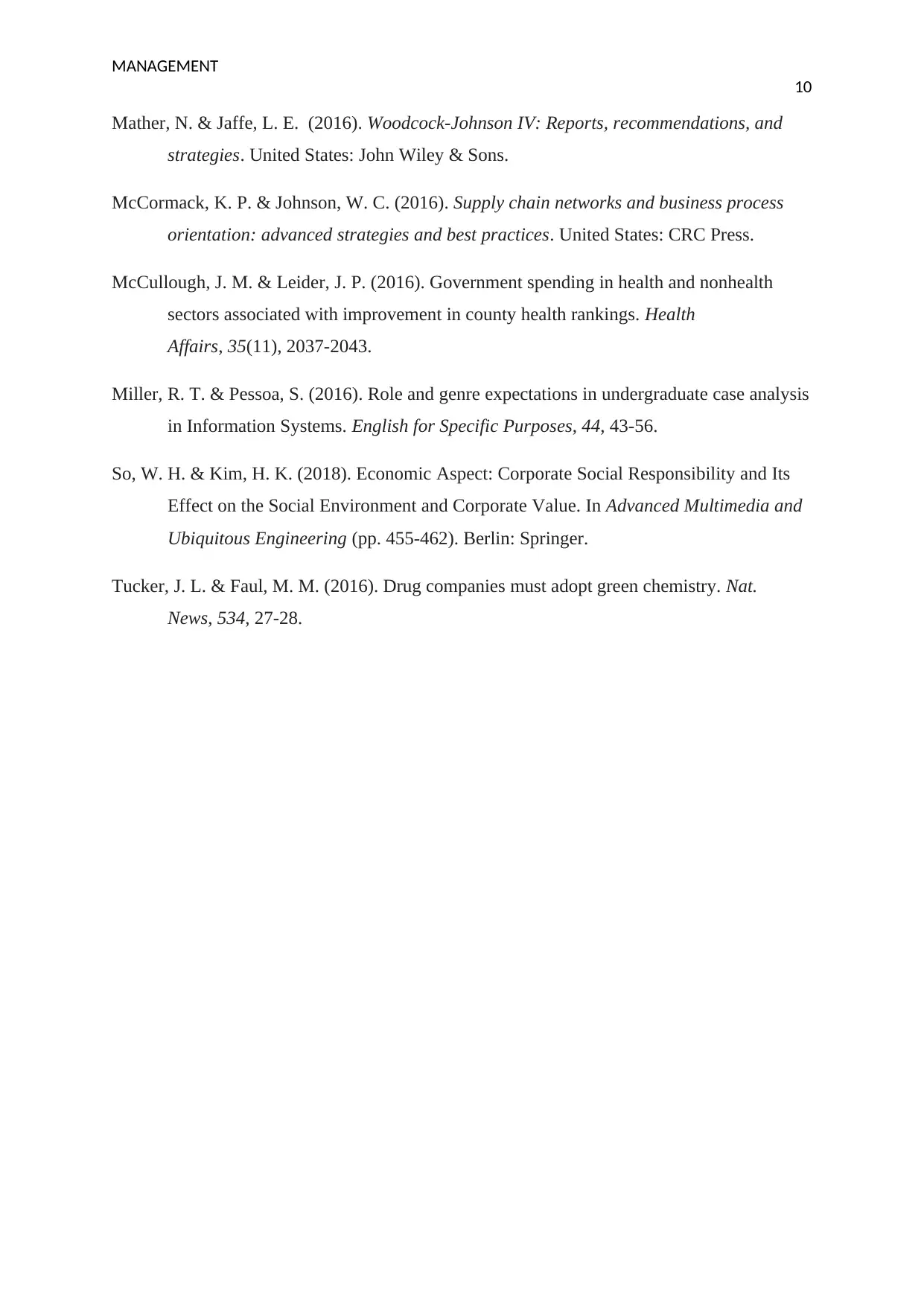
MANAGEMENT
10
Mather, N. & Jaffe, L. E. (2016). Woodcock-Johnson IV: Reports, recommendations, and
strategies. United States: John Wiley & Sons.
McCormack, K. P. & Johnson, W. C. (2016). Supply chain networks and business process
orientation: advanced strategies and best practices. United States: CRC Press.
McCullough, J. M. & Leider, J. P. (2016). Government spending in health and nonhealth
sectors associated with improvement in county health rankings. Health
Affairs, 35(11), 2037-2043.
Miller, R. T. & Pessoa, S. (2016). Role and genre expectations in undergraduate case analysis
in Information Systems. English for Specific Purposes, 44, 43-56.
So, W. H. & Kim, H. K. (2018). Economic Aspect: Corporate Social Responsibility and Its
Effect on the Social Environment and Corporate Value. In Advanced Multimedia and
Ubiquitous Engineering (pp. 455-462). Berlin: Springer.
Tucker, J. L. & Faul, M. M. (2016). Drug companies must adopt green chemistry. Nat.
News, 534, 27-28.
10
Mather, N. & Jaffe, L. E. (2016). Woodcock-Johnson IV: Reports, recommendations, and
strategies. United States: John Wiley & Sons.
McCormack, K. P. & Johnson, W. C. (2016). Supply chain networks and business process
orientation: advanced strategies and best practices. United States: CRC Press.
McCullough, J. M. & Leider, J. P. (2016). Government spending in health and nonhealth
sectors associated with improvement in county health rankings. Health
Affairs, 35(11), 2037-2043.
Miller, R. T. & Pessoa, S. (2016). Role and genre expectations in undergraduate case analysis
in Information Systems. English for Specific Purposes, 44, 43-56.
So, W. H. & Kim, H. K. (2018). Economic Aspect: Corporate Social Responsibility and Its
Effect on the Social Environment and Corporate Value. In Advanced Multimedia and
Ubiquitous Engineering (pp. 455-462). Berlin: Springer.
Tucker, J. L. & Faul, M. M. (2016). Drug companies must adopt green chemistry. Nat.
News, 534, 27-28.
1 out of 11
Related Documents
Your All-in-One AI-Powered Toolkit for Academic Success.
+13062052269
info@desklib.com
Available 24*7 on WhatsApp / Email
![[object Object]](/_next/static/media/star-bottom.7253800d.svg)
Unlock your academic potential
Copyright © 2020–2025 A2Z Services. All Rights Reserved. Developed and managed by ZUCOL.





